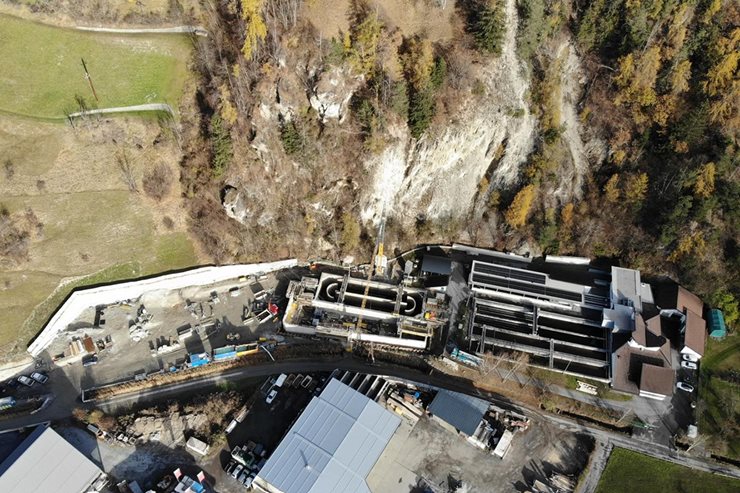In the heart of the Tyrolean Oberland tourist region, the Prutz wastewater treatment plant has reached its capacity limits. While operations continue and the high season is in full swing, the plant is now being rebuilt. Read on to find out how the sewage treatment plant is mastering this balancing act between the high season and the local construction site and ensuring the treatment capacity during the construction work.
Prutz: a tourist hotspot with a rich histor
Prutz is located in the “Oberes Gericht”, the uppermost part of the Tyrolean Inn Valley between the Swiss border and the town of Landeck. Landeck is the first major town to enter the region from the west. Alongside the Brenner Pass, the nearby Reschen Pass is one of the most important Alpine crossings between Germany and Italy.
Settlement on the sunny valley slopes dates back to the Bronze Age, when trade and metal export routes ran from the Inn Valley over the Maloja Pass towards northern Italy. After the conquest of the Alps by the Romans in 15 BC, the Inn Valley became part of the Roman province of Rhaetia and was integrated into the Via Claudia Augusta road network - an important trade route from Italy to Augsburg.
After the Romans withdrew in the late 5th century AD, the Bavarians settled in the Inn Valley. The immigration of the Germanic tribe was slow, which meant that in some places, such as Nauders, Rhaeto-Romanic survived until the 17th century. Traces of this language can still be found today in dialects and place names, and Rhaeto-Romanic is still spoken in the neighboring Engadin in Graubünden.
Prutz and the Oberes Gericht are therefore not only a bridge between different peoples geographically, but also culturally. With this traditional charm, Prutz awaits its visitors at the entrance to the Kaunertal valley at 864 meters. The picturesque vacation resort, with views of the Tyrolean mountains, is a vacation paradise for those seeking relaxation, active sports enthusiasts and families!
Sustainable wastewater treatment plant for 28,000 population equivalent
Since 1985, nine municipalities have been treating their wastewater at the Prutz wastewater treatment plant. The wastewater association Prutz und Umgebung was founded in 1977 and comprises the municipalities of Faggen, Fendels, Fiss, Kaunerberg, Kaunertal, Kauns, Ladis, Prutz and Ried im Oberinntal.
The association area is strongly characterized by tourism and agriculture and is home to around 7,000 inhabitants. With around 2 million overnight stays per year, the tourism industry accounts for the largest share of the total wastewater volume.
The Prutz wastewater treatment plant is currently designed for a capacity of 28,000 population equivalents (PE):
- The wastewater treatment plant is a classic activated sludge plant with upstream denitrification.
- The sludge produced is statically pre-thickened, treated anaerobically (in the digestion tower) and then mechanically dewatered (screw press).
The fermentation gases produced from the sewage sludge can be used to heat the sewage treatment plant in winter.

Figure 2: The Prutz wastewater treatment plant is being expanded to ensure reliable wastewater treatment even during the winter season and with increasing tourist numbers. © Donau Chemie AG
The challenge: expanding treatment capacity during ongoing operation
In the winter months, the wastewater treatment plant has been reaching its capacity limits for years. However, security of supply must be guaranteed, especially in winter. In 2017, a project was therefore submitted to the authorities to expand the existing wastewater treatment plant to a capacity of 45,000 PE.
Following approval in 2019, the
mechanical treatment stage was initially adapted in a first construction phase. However, the start of the second construction phase was delayed due to the COVID-19 pandemic, meaning that work could not begin until June 2024. In the course of this phase, two new secondary clarifiers and an additional aeration tank will be built, integrating the existing tanks. The total costs of the conversion project amount to around 10 million euros. The conversion is expected to last until 2028.
In addition to the ongoing conversion work, the intensive vacation operations and the low acid capacity of the plant are currently posing considerable challenges - these factors are putting a noticeable strain on operations and require flexible solutions.
Read also: Wastewater treatment simply explained: the 4 purification stages
The solution: Precipitant and chalk for stable wastewater treatment
With the addition of chalk and an individually tailored Donau Chemie iron-aluminum mixture, we achieve a stable floc structure that increasingly binds filamentous bacteria into the compact floc.
In addition, sludge is made heavier in the biological treatment, dewatering is optimized and the growth areas for nitrifying bacteria are increased to ensure a safe and, above all, more stable cleaning process in the plant.
These accompanying measures will ensure that wastewater treatment operations continue despite ongoing construction work!
The combined solution presented here has already proven itself with many customers. If you would like to find out more, please contact us via our website!